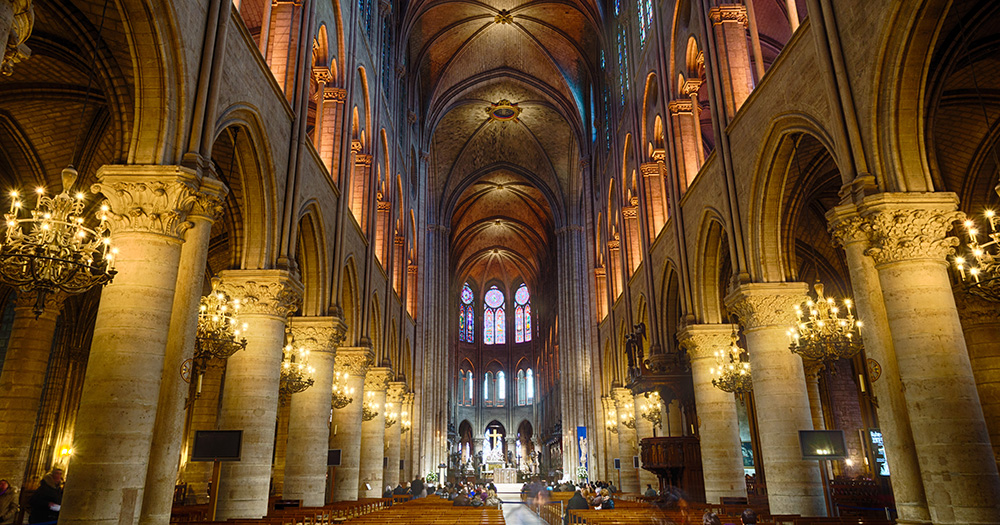The heart of Paris has been burned.
style="display:block; text-align:center;" data-ad-layout="in-article" data-ad-format="fluid" data-ad-client="ca-pub-8151337340296717" data-ad-slot="5584281553">
On April 15, 2019, the Notre Dame Cathedral in Paris went up in flames, causing the cathedral's spire and roof to collapse.
It’s falling pic.twitter.com/TE705LNfdw
— Hash Miser (@H_Miser) April 15, 2019
And it is a disaster that has evoked a raw outpouring of emotion from the French public in general -- as well as from around the world.
https://twitter.com/OusamaBinGharib/status/1117934876731121664
What is it then about the cathedral, that holds such a special place for the French?
style="display:block; text-align:center;" data-ad-layout="in-article" data-ad-format="fluid" data-ad-client="ca-pub-8151337340296717" data-ad-slot="5584281553">
A symbol of French civilisation
In the words of The Guardian, Notre Dame is:
"... the cathedral of French cathedrals, with one of the longest and richest of histories: the site of royal weddings, the consecration of Napoleon Bonaparte as emperor and the beatification of Joan of Arc. It is also where the public celebrates the lives of the great and good."
The cathedral was first constructed in 1163, during the reign of French King Louis VII, with then Pope Alexander III witnessing the laying of the first stone, both The Guardian and The New York Times reported.
Its construction had been the outcome of Louis VII's intention that the cathedral serve as a symbol of French political, economic, intellectual and cultural power, both domestically and internationally, The Guardian added.
However, the cathedral's construction would only be completed nearly 200 years later, in 1345.
Still, the long period of construction did not hamper the original intent of Louis VII for the cathedral to be a civilisational symbol -- the cathedral is considered a paragon of medieval Gothic architecture, according to NYT.
Additionally, Notre Dame also came to be synonymous with political power and control of France.
Henry VI of England was made king of France inside Notre-Dame in 1431, while Napoleon Bonaparte, was also crowned emperor within its walls in 1804.
style="display:block; text-align:center;" data-ad-layout="in-article" data-ad-format="fluid" data-ad-client="ca-pub-8151337340296717" data-ad-slot="5584281553">
A witness and victim to violent moments of French history
That's not to say the cathedral has always been so revered throughout its history.
In the 16th century, a group of French Protestants known as the Huguenots damaged several of the statues they considered idolatrous, Time reported.
Moreover, one of the reasons why Victor Hugo's 1831 novel The Hunchback of Notre Dame has been considered a seminal piece of literature was because it brought the public's attention to the decrepit state of the cathedral at that time, NYT reported.
One major factor for its condition at that time was the cathedral's desecration, in 1793, during the French Revolution, by anti-royalists who declared that the cathedral would be converted into a "temple of reason", both NYT and Time reported.
Statues of biblical kings were removed and decapitated by the anti-royalists, in their belief that the statues actually represented French kings, Time and Live Science reported.
These statues were re-discovered in 1977 and subsequently restored.
The original spire of the cathedral was also demolished during this period, although news sources differ on why it came down.
Time said the spire was removed in 1786 because it wasn't stable.
Live Science said the spire was torn down by the anti-royalists.
In any case, in spite of Bonaparte's coronation in 1804, no major restorative work was undertaken until 1843, with Hugo's novel having helped to renew interest in the building once more.
style="display:block; text-align:center;" data-ad-layout="in-article" data-ad-format="fluid" data-ad-client="ca-pub-8151337340296717" data-ad-slot="5584281553">
Not every part of the cathedral is 850-years-old
As such, it is the restoration that commenced in 1843 that has been credited with giving Notre Dame much of its present-day appearance, Live Science reported.
Headed by French architect Eugène-Emmanuel Viollet-le-Duc, the restoration took 20 years, which among other things, saw the addition of the cathedral's iconic gargoyle statues, the painting of new murals, as well as the restoration of the now-collapsed spire.
The restoration also saw the construction of a sacristy, where priests prepare for worship services, along with the reconstruction of the cathedral’s organ.
Destruction and restoration are part of Notre Dame's history
At this point, if you have connected the dots, you'd have realised that destruction and restoration is pretty much an integral part of Notre Dame's history, as Time suggested in its headline.
style="display:block; text-align:center;" data-ad-layout="in-article" data-ad-format="fluid" data-ad-client="ca-pub-8151337340296717" data-ad-slot="5584281553">
Which is why one should perhaps not be too surprised at how the current disaster has already brought in a slew of pledges worth hundreds of millions of euros from tycoons, both French and foreign, and business leaders, the Financial Times reported.
Thus far, the pledges from luxury firms LVMH Group, Kering and L'Oreal amount to a combined total of roughly 500 million euros, CNN said.
The CEO of Apple, Tim Cook, has also pledged to donate to the rebuilding of Notre Dame, according to a tweet on April 16.
We are heartbroken for the French people and those around the world for whom Notre Dame is a symbol of hope. Relieved that everyone is safe. Apple will be donating to the rebuilding efforts to help restore Notre Dame’s precious heritage for future generations.🇫🇷
— Tim Cook (@tim_cook) April 16, 2019
In summing up the significance of Notre Dame and the grip it exerts on the French consciousness, French President Emmanuel Macron stated, as per FT:
"Notre-Dame de Paris is our history, our literature, the life of our imagination, the place where we have lived all our great moments, our epidemics, our wars, our liberations. It’s the epicentre of our life."
More details on the blaze:
Top image by Miguel Mendez via Flickr
If you like what you read, follow us on Facebook, Instagram, Twitter and Telegram to get the latest updates.
